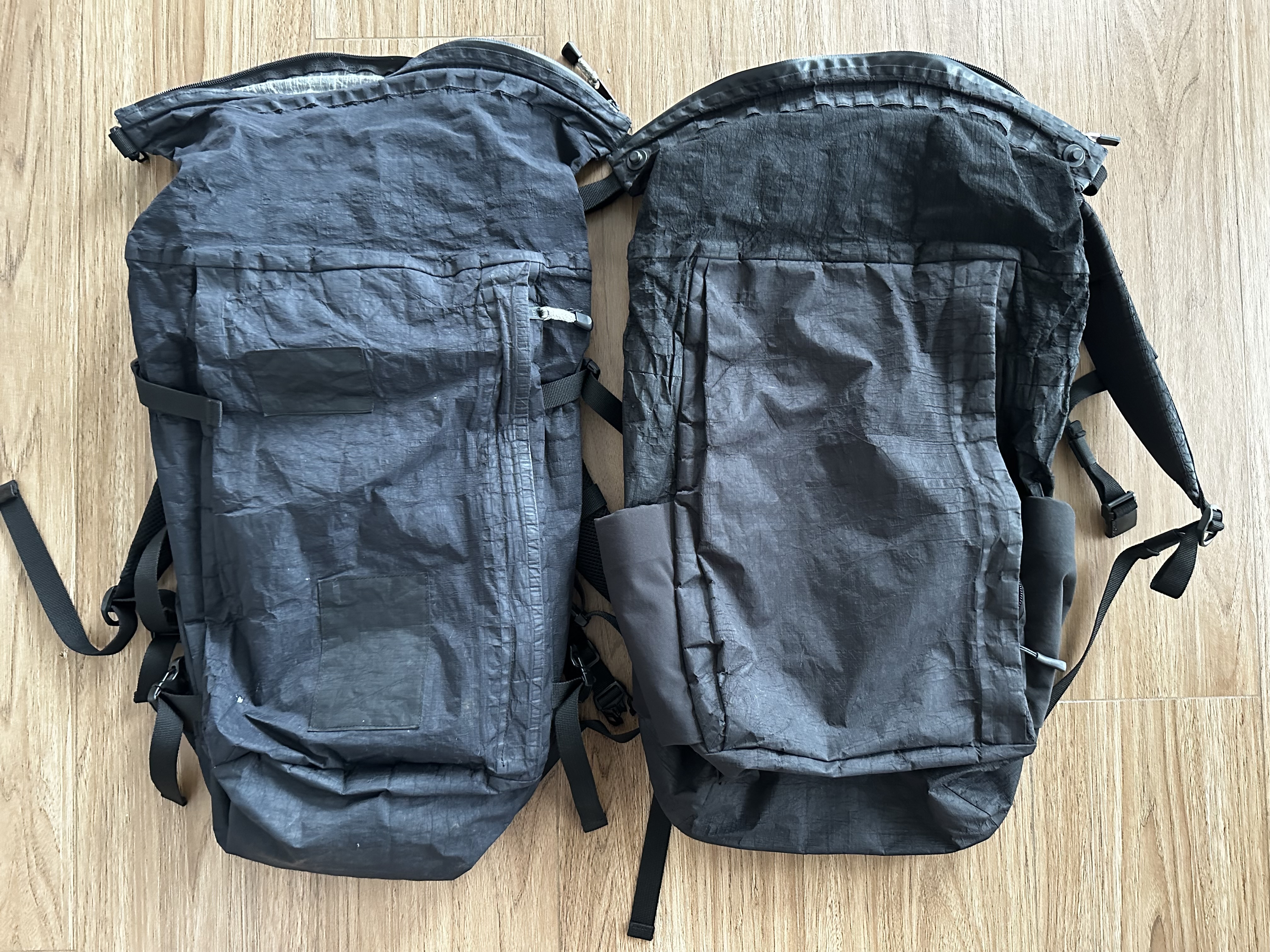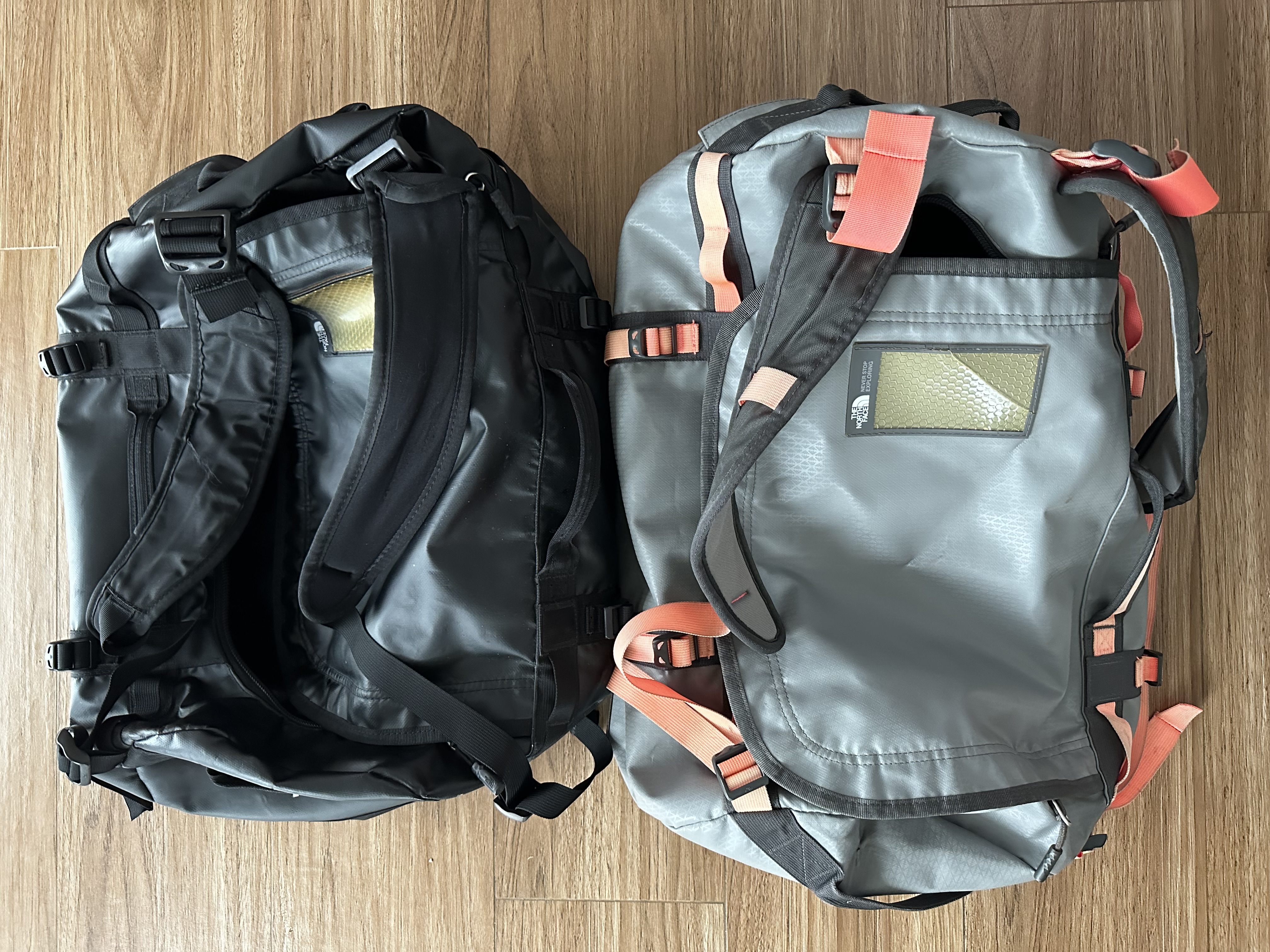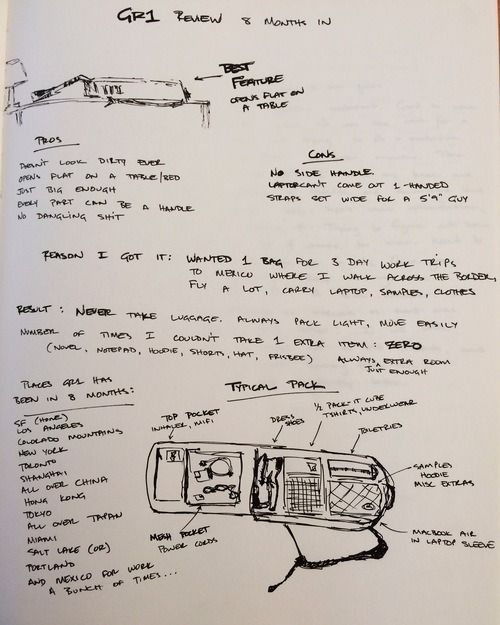The 2019 discovery of Rofmia in many ways represented the culmination of all my prior backpack hunting. After years of traveling with the North Face Base Camp Duffel and the Outlier Rolltop rolled up inside, I’ve transitioned to a true one bag solution with the Rofmia Backpack. As I have both v1 and v2, this is a review of both models. The v1 I have is the 40L size, and although Rofmia has take down the images there are some good reviews on Reddit here and here. The v2 has been thoroughly reviewed here as well. My thoughts, then, are a supplement, rather than a replacement for those notes. As such, let me begin by saying it’s a pleasure to review a simply-named item. Rofmia barely brands their products and uses a simple naming scheme. After years of long and inelegant product names, I feel great delight at reviewing a backpack called simply “backpack”.
We bought the 40L v1 in person at the shop in Minokamo in the fall of 2019. That sentence explains much of the reason I no longer read bag reviews. I’ve spent twenty years in manufacturing, learning how things were made, and for years that knowledge has led me to value things made in the US or in places I live or have lived, by people I know. For years I’ve valued the world we are building by buying things as much as the things we are buying. Money before words, as my GR1 review, now a decade old, states. The Rofmia backpack is sustainable in that the human endeavor required to produce it will support the producer. This may be the only thing that matters.
As for the v1, after that purchase we have carried it around Japan many, many times, to Vietnam, Ireland, Taiwan, and Thailand, as well as across the US a half dozen times, if not more. The v2 was purchased on release in 2020, and has been around used in Hong Kong extensively, as well as across the US, Japan, and on several shorter trips to China and Taiwan.
Any conversation about these bags has to start with dyneema and a philosophy of travel. Re-reading my review of the Outlier bag, I realize I perhaps haven’t discussed the first aspect enough. As documented across this site, I’ve been trying to travel with less for years. I’ve also been trying to live with less, when on the road and at home. In some situations that has lead to spending quite a bit of money on bags, and I recognize the inconsistencies. For those who’ve never had a dyneema bag, the value is hard to explain. Dyneema feels unlike any other material, and its properties are quite different than anything else I’ve used in bags. Unlike the TPU laminate of the North Face Base Camp Duffel, it isn’t abrasion resistant. Unlike more common cordura or nylon, it doesn’t stretch at all. And unlike all of these, it’s very loud, crinkling like a stiff paper bag when rolling and closing. The tradeoff is that it’s solid, strong, and light. Comparing the dyneema of the Outlier Ultrahigh or Rofmia bags to the cordura of the GR1, for example, is like comparing an F150 to a bicycle, or a house to a tent. They feel like entirely separate objects. The GR1 has a durability that can’t be disguised, and is wonderful. It’s also heavy, for a backpack. The dyneema bags feel like a thin tarp, or a thick paper bag, in some way both utilitarian and temporary. The Rofmia and Outlier have more in common with the blue Ikea bags than cordura ones, albeit with better hand feel.
My first dyneema bag, the Outlier Ultrahigh Rolltop, remains one of my favorite items of all time, and for years was the best bag I’d ever used. It still may be. The Ultrahigh was my first experience with a bag that I wanted to carry empty, just in case, because carrying it empty didn’t affect what I was comfortable doing in any way. That’s the difference between heavy things and light ones. Heavy things, eventually, affect what we’re willing to do while carrying them. As someone who always wants to walk, who is constantly looking to climb things, to run, and to go just a bit farther than I’d meant to, the lack of weight in my belongings sets me free. Having lightweight bags and fewer items also allows me to carry things for others, without feeling overburdened. The Rofmia backpack v1 is the ultimate embodiment of this philosophy, and in many ways feels untouchable. Consider, briefly, this table of bag weights and sizes that I’ve maintained in Notes for years. Please don’t consider the kind of person who maintains such a table.
| Bags owned | Volume | Weight | Note |
|---|---|---|---|
| Rofmia Tote (v1) | 15L | 235 g | Dyneema tote |
| Ghostly x RPMG dyneema | 12L | 298 g | Dyneema rolltop backpack |
| Outlier Ultrahigh rolltop | 20/28L | 526 g | Dyneema rolltop backpack |
| Outlier Nexhigh rolltop | 20/28L | 600 g | X-pac rolltop backpack |
| Rofmia Backpack (v1) | 40L | 600 g | Dyneema rolltop backpack |
| Rofmia Backpack (v2) | 35L | 830 g | Dyneema rolltop backpack |
| Peak Tote (v1) | 18-20L | 900 g | Heavy tote |
| North Face Base Camp S | 50L | 1230 g | Lightweight duffel |
| Goruck GR1 | 26L | 1451 g | Cordura backpack |
| Peak Travel Backpack | 35-45L | 2041 g | Super heavy, can’t use, given away |
Clearly the Rofmia backpacks (both, but especially v1) stand out for the combination of weight and capacity. It is twice as big (closed) as the Outlier and weighs less than half the North Face duffel I’d been carrying. Coupled with the collapsable design that enables the bag to be used in place of both (expanded for travel, cinched down for meetings and daily carry around town), and the Rofmia is unparalleled.
In the interest of staving off questions, yes, I have a list of other bags I’ve looked at but not purchased, for one reason or another, for comparison. Those are below.
| Bags of interest | Volume | Weight | Note |
|---|---|---|---|
| Able Carry XPac Daily Backpack | 20L | 900 g | X-pac backpack |
| Arctery’x Veilance Nomin | approx 20L? | 930 g | Lightweight material? |
| Bellroy Shift | 22L | 1250 g | Unknown material |
| Freitag F303 Hazard | 19L | approx 1500 g? | Feels larger, unique colors, heavy |
| Arctery’x Blade 28 | 28L | 1460 g | Normal backpack materials |
| Arctery’x Granville 16 | 16L | 750 g | Lightweight material, flap opening |
The obvious next question is “why do we also have a v2?”
An answer is that there are two of us.
Another answer is the changes. The Rofmia backpack v2 adds the following features I appreciate: fidlock closures (instead of clips), a zip-opening for the laptop slot, two external water bottle holders, and a sunglasses/cellphone zip pocket on top. There are also a half-dozen other improvements, like the internal compression and a nicer arrangement of the internal front pocket areas, that are interesting but not why we own both. The trade, of 5L of storage for 230 g, makes for a much nicer daily bag around town. Having water bottle slots, a place to quickly store a phone, and most critically a way to access the laptop slot without unrolling, are all great changes. Fidlocks make for a faster, nicer experience. The bag is still wonderfully expandable, and can hold a ton of groceries or whatever surprising gear needs arise.
However, for long international travel with one bag and little gear, the v1 still reigns supreme. In 2022 I went on solo trip of the kind that used to dominate my pre-covid life: a whirlwind ten days in Ireland, New York, and San Francisco. This trip required work clothes, casual clothes, cold weather gear, hot weather gear, a laptop and a variety of other nonsense. Because I was flying solo, I had the pick of v1 or v2, and v1 provided the extra capacity that was critical by the return flight. In terms of the method, for readers who have not tried true one bag travel, it is unparalleled, assuming physical mobility.
The ability to carry on in all situations is absolutely worth the volume constraints, as I leave airports up to 45 minutes prior to fellow passengers, and am never concerned about transfers, delays, re-bookings, or similar issues. I also never wonder what bag anything is in. The tradeoffs, of having to carry everything at all times, are acceptable, and incentivize a lighter lifestyle. On the above occasion I spent my nine free hours in Dublin (after taking the bus into the city immediately on landing) walking, covering some 20 km while carrying everything I had brought. While definitely a burden, the ability to carry all my gear allowed me to enjoy my free time in a new city in a way that would not have been possible with a suitcase or even multiple bags. With my old duffel set up it would have been possible, but less comfortable. For nine hours of walking, every gram matters.
The v1’s compromises, mostly of no laptop slot and no water bottle holders, are well worth the weight trade off. The internal compression, while cleaner, is less flexible, and I’d stick to the v1 external style. The phone/sunglasses zip pocket is wonderful, but not necessary. And the fidlocks, while nice, aren’t enough nicer to be worth the weight. The only change I’d truly fight for is the laptop slot, but after five years, I can say it’s ok without. I can also say I’m very curious about the v1.5 Rofmia built for a custom release for Lister, which seems to match my feedback, and is probably the type of thing I’d request custom if I ever need another.
The most honest statement I can make about the Rofmia Backpack v1 is what I said at the beginning: I stopped reading about backpacks after getting it. Five years later it remains one of my favorite objects of all time, and I no longer look for alternatives.
Given the length and positive nature of this review I should acknowledge some remaining points briefly.
First, price. Dyneema is an expensive material. In addition, bags hand made by people in developed countries that I personally have met are expensive products. For these reasons, and due to the odd and temperamental nature of Dyneema, I don’t point friends in the direction of these when I am asked for my backpack suggestions. Instead I suggest some of the bags of interest, hence that portion of the list above. I fully understand that our use case, of wanting to fly internationally with only a carry on, and have that carry on then usable as a day bag, is both esoteric and unnecessary. Still, it remains part of both of our personal and professional lives, and is a great experience. Beyond desire, I understand budget constraints and the inherently lower value sometimes placed on hand-made items. I have always placed a large value on knowing who made things. It’s a huge part of why I’ve spent the last twenty years in factories, and as part of global supply chains. In many ways I am willing to pay more for that knowledge, and visiting Rofmia in Minokamo, recounted in this post, was wonderful, and is exactly why we travel.
Second, durability. Dyneema is not a forever material. It will wear out, or shred, slowly becoming ever more ephemeral until there are holes. Many bags at similar price points promise “purchase once use forever” or similar slogans. Durable enough to be handed down to the next generation, for me, is of value in watches but not in backpacks. I also am well aware that selling one item to a customer per lifetime makes for a difficult business, and will be ok with whatever happens in five years or ten, when my time with this bag is up. This does however stop me from recommending dyneema bags to any and all.
Lastly, as my partner recently exclaimed, “these bags are expensive, fine, but they’re always sold out!”. It’s true. Outlier no longer makes a dyneema bag. Rofmia usually sells out new stock within a couple of days. And the Ghostly x RPMG bag listed here was made twice and probably never again, in small runs both times. This is the nature of expensive boutique items with odd markets, and I am not surprised. I do understand that it makes for a difficult recommendation.
Ah well. Perhaps given the difficulty of acquisition this review will be of use. To those, then, for whom backpacks are an open category of research and purchase; to those people still in search of a perfect bag: the Rofmia v1 backpack is that.
At least for me.


